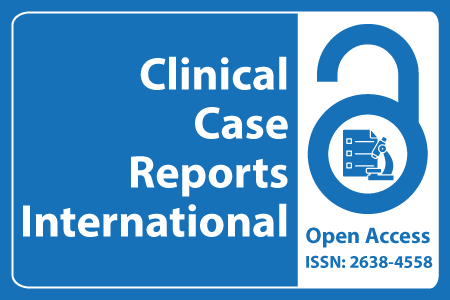
Journal Basic Info
- Impact Factor: 0.285**
- H-Index: 6
- ISSN: 2638-4558
- DOI: 10.25107/2638-4558
Major Scope
- Ophthalmology
- Women’s Health Care
- Veterinary Sciences
- Chronic Disease
- Urology Cases
- Sexual Health
- Radiology Cases
- Cardiology
Abstract
Citation: Clin Case Rep Int. 2024;8(1):1658.DOI: 10.25107/2638-4558.1658
Subacute Secondary Hematogenous Osteomyelitis Involving the Distal Fibular Epiphysis: A Case Report
Huang K, Zhao N, Guan J and Li K
Department of Orthopedics, The First Affiliated Hospital of Bengbu Medical College, China
Department of Orthopedics, The First Bethune Hospital of Jilin University, China
*Correspondance to: Jianzhong Guan
PDF Full Text Case Report | Open Access
Abstract:
Introduction: Hematogenous osteomyelitis usually occurs in children, causing the absorption and destruction of bone. It often involves the metaphysis of a long bone, such as the distal femur or proximal tibia. However, hematogenous osteomyelitis involving the epiphysis is rare. To our knowledge, no case of subacute secondary hematogenous osteomyelitis occurring at the distal fibular epiphysis has been reported yet. Patient Concerns: A 6-year-old male patient presented with pain in his left ankle for a month without trauma. No respiratory or other infections were reported in the patient’s recent medical history. There were no significant abnormalities in the Erythrocyte Sedimentation Rate (ESR) and C-Reactive Protein level (CRP). Diagnoses: A plain radiograph of the left ankle joint showed an elliptical bone defect at the distal epiphyseal plate and epiphysis of the fibula of the left ankle joint. Computed Tomography (CT) of the left ankle joint showed a partial defect of the left fibular epiphyseal plate and lateral epiphysis with an osteosclerotic zone. The Magnetic Resonance Imaging (MRI) scan showed that the lesions had grown through the epiphyseal plate in the distal left fibula and involved the epiphysis. Intervention: We performed curettage of the left lateral malleolus lesion and administered intravenous antibiotics to the patient for 3 weeks beginning on postoperative day 1. Outcome: We followed up the child for 3 months, during which he underwent plain radiographic reexamination, which showed no signs of early fusion in the epiphyseal plate. He recovered well after surgery. Lessons: When clinicians are diagnosing similar cases, they should first be aware of the fact that osteomyelitis may occur in relatively rare sites, and that an early MRI examination should be performed to avoid missed diagnosis and misdiagnosis.
Keywords:
Child; Distal fibular epiphysis; Osteomyelitis; Epiphyseal plate; MRI
Cite the Article:
Huang K, Zhao N, Guan J, Li K. Subacute Secondary Hematogenous Osteomyelitis Involving the Distal Fibular Epiphysis: A Case Report. Clin Case Rep Int. 2024; 8: 1658.













